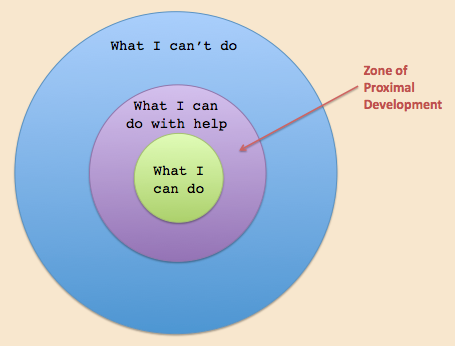English Language Learners(ELLs) consist of almost 10% of the student population in the U.S. This means that, as educators, you will face the challenge of teaching ELLs at some point. ELLs, themselves, face unique challenges in the classroom. This web site is dedicated to informing educators about scaffolding strategies that will enhance learning for ELLs in your mainstream classrooms.
Scaffolding occurs when teachers provide students with support during the learning process to help them achieve their learning goals, and to promote a deeper level of learning. As a teacher, you would provide students with support until, eventually, they become independent, self-regulated learners.
Scaffolding is like using Training Wheels:
They are both used temporarily and meant to be removed.
They are both used temporarily and meant to be removed.
Scaffolding is linked to Vygotsky's
Zone of Proximal Development (ZPD)
Vygotsky's Zone of Proximal Development (ZPD)
The difference between what a learner is not yet capable of doing independently and what they are capable of doing on their own.
Zone of Proximal Development (ZPD)
Vygotsky's Zone of Proximal Development (ZPD)
The difference between what a learner is not yet capable of doing independently and what they are capable of doing on their own.
|
The skills and knowledge that are within a student's ZPD are those that have not yet emerged but, could emerge by interacting with others who are more knowledgeable(teachers, peers, etc.). Vygotsky believes that your role as educators is to provide learning opportunities that are in the student's Zone of Proximal Development to encourage, and advance, their individual learning.
The following video explains Vygotsky's
Zone of Proximal Development: |
|
Scaffolding plays an important part in ELLs' development of self-talk, memory and strategy use
The following video discusses scaffolding:
Scaffolding, ZPD and ELLs
Educators have traditionally approached language learning as a process that is separate from the process of teaching content knowledge. This approach leaves ELLs especially unprepared to work with complex texts and the academic language that is required to be successful in the mainstream classroom.
As an Educator, you can combine Scaffolding and
ZPD to benefit ELLs by:
Educators have traditionally approached language learning as a process that is separate from the process of teaching content knowledge. This approach leaves ELLs especially unprepared to work with complex texts and the academic language that is required to be successful in the mainstream classroom.
As an Educator, you can combine Scaffolding and
ZPD to benefit ELLs by:
- Recognizing where your ELLs are in their learning process
- Aiming instruction within the ELL's ZPD
- Using scaffolding in your lesson plans to assist Ells in mastering more advanced language skills and content concepts
For More information on Scaffolding and
the Zone of Proximal Development,
click the link below:
the Zone of Proximal Development,
click the link below:
The following video discusses scaffolding for ELLs. Scaffolding is beneficial for all students but,
in particular for ELLs.
in particular for ELLs.


